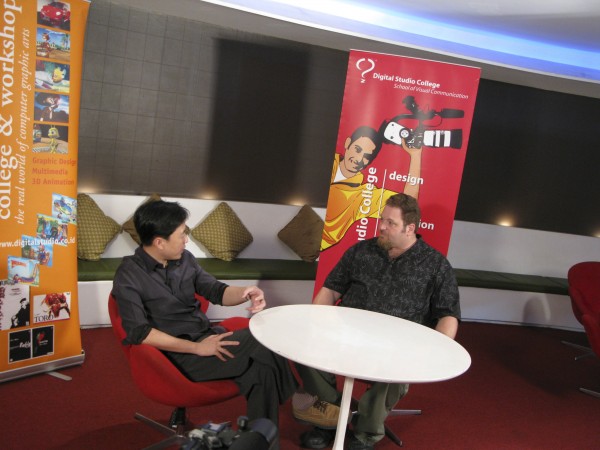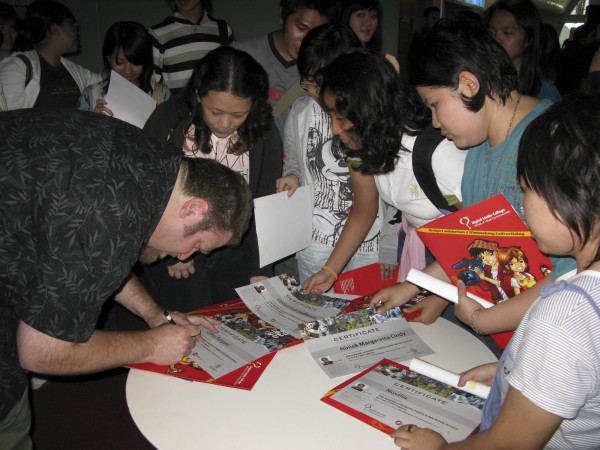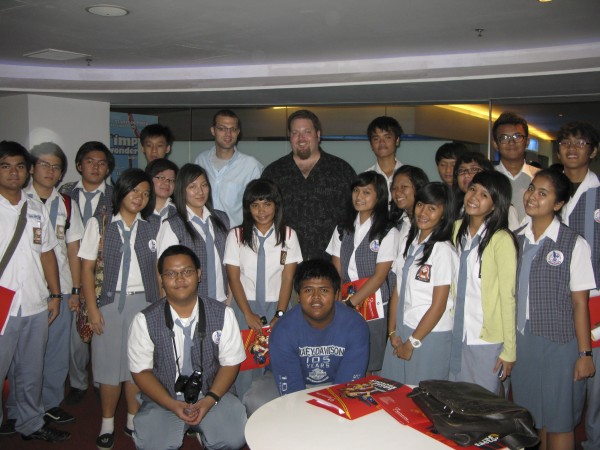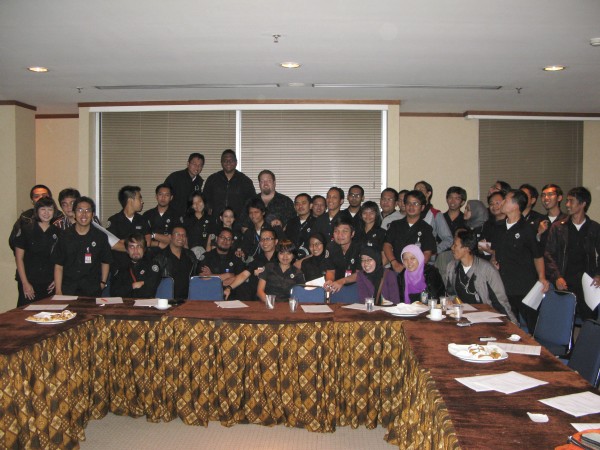Saturday, September 27, 2008
Friday, September 26, 2008
Ekosistem Industri Kreatif di Indonesia
Oleh: Andi S. Boediman
Strategic Innovation Consultant,
Creative Industry Evangelist
www.ideonomics.com
Dimuat di QBHeadlines
Mungkin belum banyak orang yang paham tentang industri kreatif. Mungkin juga banyak yang mengira industri kreatif sebagai sesuatu yang baru, padahal nyatanya tidak begitu. Kreatif industri sudah ada sejak jaman dahulu. Bahkan, UK Government Department of Culture pernah menyebutkan, kegiatan apapun yang dilakukan oleh seseorang, dengan mengandalkan kreativitas, keahlian, dan bakatnya; yang memiliki potensi ekonomi dan mampu menciptakan peluang kerja bagi banyak orang, dapat dikatakan sebagai industri kreatif.
Inggris kehilangan industri manufakturnya karena outsourcing dan offshoring. Tenaga kerja murah menggantikan produksi di negara-negara maju menjadi tidak feasible. Industri kreatif sebagai industri terbesar kedua di Inggris setelah finansial ternyata mampu memberikan kontribusi value added yang luar biasa.
Menurut definisi Inggris, industri kreatif dapat dikelompokkan menjadi beberapa subsektor—periklanan, arsitektur, ketrampilan dan desain furnitur, fashion clothing, produksi film dan video, desain grafis, aplikasi komputer dan games, musik live maupun rekaman, hiburan dan seni panggung, televisi, radio, dan internet broadcasting; seni visual dan barang antik, serta industri surat kabar dan penerbitan.
Sesuai dengan definisinya, kreatif industri sangat mengandalkan kreativitas, keahlian, dan bakat seseorang. Artinya, sumber daya manusia menjadi hal terpenting untuk menciptakannya. Mengingat bahwa Indonesia adalah negara dengan populasi penduduk yang sangat besar, bisa dikatakan industri kreatif sangat cocok untuk dikembangkan di negeri kita ini.
Pasar Industri Kreatif
Perkembangan teknologi telekomunikasi mendorong peningkatan jumlah penggunaan handset. Hal itu pun mempengaruhi industri mobile secara global. Vendor telekomunikasi asal Finlandia, Nokia, melaporkan bahwa di tahun 2008, industri mobile telah berkembang senilai 625 miliar dolar AS. Dari semuanya, tercatat bahwa jumlah penggunaan layanan data meningkat sebanyak 30%, sedangkan penggunaan layanan suara dan telefoni meningkat hingga 5%. Ini berarti, industri konten berpotensi untuk tumbuh dengan pesat.
Di Jepang, industri konten menjadi industri populer yang berpotensi besar untuk menjadi industri utama—bahkan lebih besar ketimbang industri manufaktur. Fakta tersebut dirilis dalam laporan yang dibuat oleh Divisi Industri Media dan Konten, Biro Kebijakan Perdagangan dan Informasi; Kementerian Ekonomi, Perdagangan, dan Industri, Jepang.
Sebanyak 60% bisnis media di Jepang memroduksi manga dan anime. Bahkan, produksi manga mencapai tiga kali lipat produksi kertas toilet. Manga (komik Jepang) dan anime (film kartun Jepang) telah menjadi tren global—bukan hanya populer di negaranya.
Sekarang, kita beralih ke Korea. Pemerintah Negeri Ginseng itu merencanakan untuk menjadikan konten digital sebagai mesin pengembang industri TI broadband di sana. Divisi Industri Pengetahuan dan Sosial, Kementerian Informasi dan Komunikasi, Korea, berharap untuk meningkatkan rata-rata pertumbuhan ekonominya sebesar 40% dari industri game, animasi, serta konten mobile, e-learning, dan televisi digital. Saat ini, industri game memberikan sumbangan ekonomi terbesar di Korea, yakni senilai 1 miliar dolar. Model distribusinya dilakukan secara online, dengan karakteristik berdasarkan lisensi dan franchise.
Bagaimana dengan Singapura? Negeri Singa tersebut menargetkan untuk meningkatkan pendapatan domestik brutonya (PDB) dari industri kreatif, yakni dari 3% menjadi 7% di tahun 2012. Target ini akan dikejar dengan mengembangkan projek Media 21, DesignSingapore, dan Renaissance City.
Lalu, bagaimana perkembangan industri kreatif di Tanah Air? Di Indonesia, industri kreatif dapat dikelompokkan menjadi empat kelas besar—konten kreatif yang terdiri dari film, musik, iklan, konten mobile, dan karya sastra; produk kreatif yang terdiri dari fesyen, barang kerajinan, seni visual (lukisan dan foto), museum dan galeri, seni arsitektur, penerbitan, kuliner, dan desain grafis; pertunjukan kreatif seperti pertunjukan seni, tari, dan musik; serta sains kreatif yang terdiri dari game interaktif, technotainment, dan bisnis internet.
Menurut laporan yang dirilis oleh Departemen Perdagangan, industri kreatif dalam negeri menduduki peringkat ke-9 dari 10 lapangan usaha utama yang didefinisikan oleh Biro Pusat Statistik. Laporan tersebut disusun berdasarkan kontribusi PDB sektoral atas dasar harga konstan tahun 2000, untuk periode 2002-2006. Rata-rata, nilai kontribusi industri kreatif pada tahun 2002-2006 adalah Rp79,08 triliun, atau sebesar 4,74% dari total nilai PDB nasional. Kontribusi PDB terbesar adalah pada tahun 2006, yakni sebesar Rp86,914 triliun atau 4,71% dari total PDB nasional.
Pendidikan dan Penghargaan
Kita dapat mengukur tingkat kompetisi ekonomi suatu negara berdasarkan tiga faktor yang sering disingkat 3T, singkatan dari Technology, Talent, dan Tolerance. Istilah 3T itu digagas oleh Richard Florida dalam bukunya yang berjudul The Rise of the Creative Class. Pendidikan bisa dikatakan sebagai salah satu faktor yang dibutuhkan untuk mendapatkan 3T itu.
Ada beberapa momen bersejarah yang dipercaya mempengaruhi perkembangan dunia pendidikan, termasuk di antaranya adalah revolusi industri (1760-1830), perang sipil (1776-1782), dan revolusi Prancis (1789). Sejarah tersebut juga mempengaruhi kebutuhan pendidikan, mendorong peningkatan kreativitas sumber daya manusia dan terciptanya industri kreatif.
Terjadinya revolusi TI pertama di akhir 1900-an—ditandai dengan lahirnya PC, multimedia, dan internet—mendorong terciptanya berbagai layanan dan aplikasi, juga pengembangan ekonomi. Revolusi TI ke-2 kemudian terjadi di awal 2000-an, ditandai dengan meningkatnya teknologi mobile dan kebutuhan akan konten yang bagus. Di sini, inovasi secara terus-menerus menjadi hal yang dituntut dari tiap orang.
Pada akhirnya, untuk terus menumbuhkan kreativitas, pendidikan kreatif juga harus diciptakan. Itulah yang mendorong lahirnya sistem taman edukasi dan pendidikan virtual yang menyenangkan. Di Thailand, konsep taman edukasi telah diaplikasikan dalam Thai Knowledge Park yang dibangun dalam sebuah pusat perbelanjaan. Anak-anak dan kaum remaja dapat datang berkunjung ke sana untuk belajar sambil bermain, dan bahkan berbelanja. Tujuan dikembangkannya taman edukasi seperti ini adalah untuk mendorong siswa berpikir lebih kreatif.
Selain pendidikan, penghargaan juga perlu diberikan bagi para pengusaha kreatif dan berbakat—untuk mendorong mereka terus berkreasi dan menumbuhkan industri kreatif. Salah satu bentuk penghargaan yang sudah ada adalah International Young Designer of The Year (IYDEY).
Selain digelar untuk merayakan bakat orang-orang kreatif, ajang penyerahan penghargaan IYDEY juga dapat dimanfaatkan untuk memperkuat jaringan dan “mempertajam” keahlian para pekerja kreatif. Pada akhirnya, ini dapat mendorong pertumbuhan industri desain internasional.
Tantangan
Industri kreatif, termasuk yang di dalam negeri, utamanya dilakoni oleh orang-orang muda kreatif. Mereka kerap menghadapi tantangan, terutama pada saat-saat awal mendirikan usahanya. Masalah modal biasanya dihadapi oleh para pengusaha kecil pemula. Untuk itu, mereka dapat mencari angel investor, istilah bagi para pengusaha yang telah sukses yang biasanya tertarik untuk membiayai industri (kreatif) baru meski risikonya besar.
Selain angel investor, para pengusaha kecil juga dapat melirik pinjaman lunak dari bank pemerintah. Bank-bank ini biasanya memiliki dana untuk menyalurkan kredit wirausaha untuk sektor usaha kecil dan menengah (UKM).
Pada intinya, untuk mengembangkan industri kreatif dalam negeri, Indonesia membutuhkan dukungan dari negara-negara tetangga sebagai mediatornya. Contohnya Singapura dan Malaysia. Lagi pula, untuk dapat menjadi bagian dari industri global, bukankah kita harus menjadi tuan di pasar sendiri (dalam negeri dan Asia) terlebih dulu?
*Artikel diolah oleh Restituta Ajeng A. dari materi presentasi Creative Industry Ecosystem in Indonesia, Andi S. Boediman.
Wednesday, September 24, 2008
Craig Xray Halperin Visits

After my Natto breakfast I met up with Denny and headed over to the MediaBlitz building. I met Adez, an animator who owns his own studio and teaches at Digital Studios. I also met Joedo who stage managed the event and Indah who MC’d. I interviewed for a podcast and went to lunch with Andi, the owner of Digital Studios as well as Paula and Mita from Koelnmesse, the producers for SIGGRAPH Asia.
Half of the folks as the table were fasting for Ramadan however I had a very nice tenderloin of Wagyu beef cooked to perfection on a hot stone on my plate. After lunch I did an interview with Andi for Digital Studios and went into the theater for the presentation. Over 200 people, many of them students, arrived for the two hour presentation.
Afterwards, many of them hung out and asked for autographs.
Romy showed up and we left for another engagement at TransTV. We had planned on getting there by 6pm to join them in breaking the Ramadan fast with the staff however we got stuck in one of Jakarta’s notorious traffic jams and were late. I gave a presentation for their internal staff. All of the TransTV staff wear uniforms. At first I thought the whole building was full of security guards but it turns out to be a staff uniform, even for the artists, editors and behind the scenes talent.
There was one white guy on the staff named Chitwa. He looked a little punk or goth but I didn’t get a chance to get his story. Afterwards, Denny, Romy and I had some drinks at a lounge, checked out a vodka bar and grabbed a late night snack at a padang style restaurant where the waiters drop off about 24 plates at the table then charge you by which ones you actually eat. Somehow they manage to carry all 24 plates at the same time. After that, I went back to the hotel and packed my bags for tomorrow’s flight to Singapore.
The people I’ve met in Indonesia have been amazingly friendly. I’m glad to have had the opportunity, however brief, to get an introduction to Indonesian culture by way of the friends I’ve met here over the past two days. Denny and Romy have been amazing guides and I hope to meet them again some day.
Sunday, September 21, 2008
The Making of Kungfu Panda & Bee Movie
Blitz Megaplex, Grand Indonesia
22 September 2008
Presented by :
Digital Studio & SIGGRAPH Asia 2008
Saat ini penggunaan animasi dan efek visual merupakan bagian tak terpisahkan dari pembuatan film. Film Kungfu Panda & Bee Movie sukses di seluruh dunia. Craig Halperin, tokoh di balik pembuatan film ini akan mengupas proses behind the scene pembuatan animasinya.
Penasaran dengan pembuatan animasi dan efek visual film Kungfu Panda & Bee Movie?
Dapatkan jawabannya dengan mengikuti Seminar “The Making of Kungfu Panda & Bee Movie”
by Craig X-ray Halperin.
Seminar akan diadakan di Blitz Megaplex, Grand Indonesia pada 22 September 2008, pk. 14.00-16.00.
Selain itu ia akan mengungkap pembuatan efek visual pada berbagai film yang pernah ia buat, di antaranya adalah Titanic dan X-Men. Di sini, live action shoot digabungkan dengan computer generated imagery untuk menghasilkan adegan yang tidak pernah terbayangkan dan di luar jangkauan akal pikir manusia. Craig akan bercerita pengalamannya di Hollywood. Profile Craig ‘X-Ray’ Halperin
Craig 'X-Ray' Halperin adalah seorang artis Visual Effects yang berkarir di film, advertising, entertainment, video games dan multimedia interaktif.
Ia membuat penumpang berjatuhan pada film Titanic, perubahan wajah Brad Pitt pada Interview with the Vampire, jatuhnya pesawat di Fight Club dan perkelahian para mutan di X-Men 2: X-Men United.
Selain itu ia memimpin tim untuk membuat crowd animation pada Bee Movie dan efek visual pada Kung Fu Panda . Craig mengajar di Gnomon School for Visual Effects di Hollywood dan juga terlibat dalam organisasi animasi ACM SIGGRAPH di Los Angeles.seminar ini bisa menjadikan sumber inspirasi bagi para pekerja kreatif, oleh karena itu seminar ditujukan untuk dihadiri oleh:
- Para pekerja kreatif yang terlibat langsung di dalam proses pembuatan film, mengetahui teknik visual effects yang digunakan dalam memproduksi sebuah film.
- Para akademisi akan mendapatkan wawasan mengenai visual effects dan kebutuhan di dunia industri film.
- Bagi mahasiswa akan mendapatkan pengalaman yang sangat menarik mengenai pembuatan visual effects film-film yang sukses di seluruh dunia.
BROUGHT TO YOU BY :
DIGITAL STUDIO
Tiket :
Early bird / Mahasiswa [ sebelum 12 September] : Rp. 150.000
Harga Normal
Registrasi & Informasi
DIGITAL STUDIO BLOK M
021-270 1518
021-270 2738-39
Fitria – fitria@digitalstudio.co.id
Denny – denugraha@digitalstudio.co.id
DIGITAL STUDIO CIDENG
021 – 633 0950
021 – 631 1246
Aya – aya@digitalstudio.co.id
DIGITAL STUDIO KELAPA GADING
021- 4584 1018
021- 7078 7107
Thursday, September 18, 2008
Benjamin Zander: Classical music with shining eyes
Since 1979, Benjamin Zander has been the conductor of the Boston Philharmonic. He is known around the world as both a guest conductor and a speaker on leadership -- and he's been known to do both in a single performance. He uses music to help people open their minds and create joyful harmonies that bring out the best in themselves and their colleagues.
His provocative ideas about leadership are rooted in a partnership with Rosamund Stone Zander, with whom he co-wrote The Art of Possibility.
"Arguably the most accessible communicator about classical music since Leonard Bernstein, Zander moves audiences with his unbridled passion and enthusiasm."
Sue Fox, London Sunday Times
Wednesday, September 17, 2008
Theo Jansen: The art of creating creatures
Dutch artist Theo Jansen has been working for 16 years to create sculptures that move on their own in eerily lifelike ways. Each generation of his "Strandbeests" is subject to the forces of evolution, with successful forms moving forward into new designs. Jansen's vision and long-term commitment to his wooden menagerie is as fascinating to observe as the beasts themselves.
His newest creatures walk without assistance on the beaches of Holland, powered by wind, captured by gossamer wings that flap and pump air into old lemonade bottles that in turn power the creatures' many plastic spindly legs. The walking sculptures look alive as they move, each leg articulating in such a way that the body is steady and level. They even incorporate primitive logic gates that are used to reverse the machine’s direction if it senses dangerous water or loose sand where it might get stuck.
"A self-styled god, Jansen is evolving an entirely new line of animals: immense multi-legged walking critters designed to roam the Dutch coastline, feeding on gusts of wind."
Wired News
Friday, September 05, 2008
Axe: From Insight to Execution
A new campaign from Axe.
How this great commercial generated?
Enjoy my side of story.
Andi S. Boediman – Strategic Innovation Consultant
_____________________
In a Friday afternoon, Shinta from Bubu called me.
What's up? Turns out we need to create digital campaign for Axe–the leading male deodorant. And we have to present all the solution on Monday morning. Goosshh! Always a deadline like that :)
On Saturday, the team, including me, Shinta and Agung–the Creative Director at Bubu sit together and review all the progress so far. We got the qualitative research, we have a few creative digital marketing solution, but we don't have the coherent BIG IDEA. Ouch, a creative idea without answering the direct big question will be a waste. It will be shooting to too many direction without aiming.
Then we have to go back to the drawing board. We start the brainstorming session, we ask questions, we challenge the solution. The execution idea didn't rings true without knowing the real problem. We see the Axe ad from all over the world and we ask WHY they come up with the solution. You know, women flocking to men. Hmmm, is this what we have in Indonesia? I don't think so. We are moslem country. And most of the user are regular male.
We look into the qualitative study based on loose interview with the target market. A pattern emerge from this interview. There is a vast difference between Indonesian male and caucasian male. Indonesian are shy, they don't have the courage to approach girls, even for just introduce themselves, not to mention asking a girl's name or getting their phone number. Aha, this is a real problem! How come you get the best girl if you don't have the confident to approach them? Could this be the MILLION DOLLAR QUESTION? The kind of question that really give a million dollar solution when you really answer them. Let's try to exercise the solution then.
Will Smith in The Hitch. This is the kind of guy that we are all dream about. Cool, smooth and really know what he is doing with girls around. Who else? The Game, a book about the secret world of pickup artist came to mind. The protagonist, Neil Strauss, is a journalist who enter this world of women seduction as 'Style' and became one of the most successful PUA (pickup artist). In this book, he shares his insight on getting a woman, from learning the pickup line, peacocking strategy, neghits and many other tips. Wouldn't it be cool if Axe can become the vehicle for guys to really know get around girls like that. This idea really cement our thought on approaching the problem.
Then we step into the next question. If Axe is the leading brand, how can the adoption is still quite small in Indonesia? What is really the problem? We look again at our target market behavior. Turns out that quite a lot of them don't buy the product themselves. They ask their mom to buy for them. And they don't admit that they use deodorant. They feel it's their problem, not others. It's common for women to use deodorant, not for men. Wow, what a shame! Then how we solve this problem?
When we see women, they have a ritual when they meet men. They use lipstick. That's why lipstick is a big category. Every woman use them. This is a big consumption. Can we turn deo becomes a consumption? Then it should become part of the ritual. What ritual do men have when meeting with women? They style their hair! Another BIG AHA! How about creating ritual, style your hair, spray your body and get the girl!
Working two looong night to prepare the strategic insight presentation. Bubu team fine tune the digital campaign to reflect this insight! Suddenly all the creative idea leads to one direction. Make Axe the vehicle for guys to get KNOWN to girls.
And on Monday morning, our full team heading to the client's presentation for idea pitching. It's a blast! From idea to execution is a matter of understanding a real problem and looking the right answer. In a matter of weeks, we got the project! Even though we have to pitch with all the big guys! Appointed as the digital marketing agency, our team at Bubu then work with all the stakeholder, the ad agency, the event organizer and the brand manager.
After a few looong meeting with all the agency and client, in the end, our crazy night becomes the leading strategic insight used even for the TV campaign and set the theme! WOW! I am so proud becomes the daddy of this insight along with the Bubu team!
Cheers to the Bubu team, cheers to the clients who really understand what we propose, and also cheers to the ad agency who did very well on adopting this idea as part of the group idea, expand them, twist them and executing this idea very well.
Looking into another story on strategic idea becomes great execution!
Keep inspired,
Andi S. Boediman





![Reblog this post [with Zemanta]](http://img.zemanta.com/reblog_e.png?x-id=743cf628-219a-4961-9cc1-4aedff079d26)